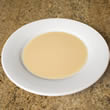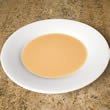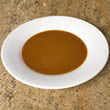All About Roux
All About Roux
Once you learn how to make roux, it will quickly become a staple item in your kitchen.
Related Articles
Related Article Collections
Roux Who?
Roux (pronounced "roo") is a thickening agent for soups and sauces with roots dating back more than 300 years in French cuisine. Made by cooking a flour and oil paste until the raw flavor of the flour cooks out and the roux has achieved the desired color, a properly cooked roux imparts silky-smooth body and a nutty flavor while thickening soups and sauces.
Roux can be made with a variety of oils and animal fats. It is commonly made with vegetable oil, olive oil, or clarified butter, but can also be prepared with bacon grease or other rendered fats. Its distinction from other thickeners is that the starch, in this case flour, is cooked before use. Cooking removes the flour's raw taste but maintains its excellent thickening properties. This enables roux to be a stable, smooth, and delicate thickener. When cooked to a golden or brown stage, roux takes on a rich, toasted flavor, adding color to a soup, stew, sauce, or other dish.
Making the Perfect Roux
Roux can be made in small quantities as part of a recipe, but its best made in larger amounts and kept on hand for use when needed. Larger quantities cook slowly and evenly, allowing the flour to achieve its maximum potential, while small amounts cook quickly, unevenly, and are easier to burn.
Whether you make a little or a lot, the proportions of ingredients are the same: 1 part oil or fat and 1 part all-purpose flour, by weight. If you have a kitchen scale, this is easy to measure. If you do not have a kitchen scale, use measuring cups or spoons to measure 1 part oil or fat and 1-3/4 parts all-purpose flour.
To make a quantity of roux, begin by heating 1 cup of oil or fat in a saucepan over medium heat until a pinch of flour sprinkled into the oil will just begin to bubble. Then, whisk in 1-3/4 cups of flour to form a thick paste the consistency of cake frosting. Continue whisking as the roux gently bubbles and cooks to the shade desired. Do not allow the roux to bubble too vigorously, or it will burn rather than brown. Be very careful while cooking roux, it becomes quite hot and can cause a bad burn if it touches the skin.
When the roux has finished cooking, pour it into a metal or heatproof container and allow it to cool. As it sits, the flour will begin to settle to the bottom, and the oil will rise to the surface. Stir the oil back into the flour before using as this will make the roux dissolve smoothly. If you decide to pour off the oil, the roux will still work, but will require more whisking into a sauce in order to fully dissolve.
After the roux has cooled, transfer it to an airtight container and refrigerate. Roux will keep indefinitely in the refrigerator or freezer until ready for use. Roux made with vegetable oil can be stored at room temperature for several weeks, but roux made with butter or fat should always be refrigerated.
Whisk it in
To ensure lump-free thickening, cold ingredients must always be added to hot. When making roux as part of a recipe, the liquid ingredient must be cold or room temperature, and slowly whisked into the hot roux. Do this by adding the liquid a little at a time, whisking until smooth between each addition, until the roux forms a thin paste, then whisk in the remaining liquid and bring the mixture to a simmer. Cold or room temperature roux is simply whisked into a simmering soup or sauce until it dissolves. These methods ensure the roux is incorporated slowly and the mixture will not form lumps.
Roux begins to thicken soon after it is combined with a liquid, but it must be simmered for 10 to 20 minutes in order to reach its full flavor and thickening potential. This additional cooking time allows the flour to soften and absorb the liquid, resulting in a silky smooth soup or sauce. If the simmering time is too short, the flour in the roux will remain grainy.
The Four Shades of Roux
There are four varieties of roux denoted by their colors: white, blond, brown, and dark brown. Brown and dark brown roux have more flavor, but less thickening power than white or blond roux. They are primarily used in Cajun and Creole dishes, most notably, gumbo and jambalaya.
White Roux
White roux is cooked for about 5 minutes, just until the flour has lost its raw smell, but before any golden color or toasted aroma develops. This roux is used to thicken chowders and milk-based sauces such as the classic white sauce, also known as Bechamel. Macaroni and cheese, tuna noodle casserole, and New England clam chowder are all based on milk thickened with a white roux.
 |
Blond Roux
Blond, or golden roux, is cooked approximately 20 minutes to a light, golden-brown shade with an aroma resembling popcorn or toasted bread. This is the most commonly used roux, desired for the richness and a slight nuttiness it provides along with its excellent thickening power. Blond roux is a good, general-purpose roux to keep on hand for thickening stock-based sauces, soups, and stews.
 |
Brown Roux
Brown roux is cooked about 35 minutes until it reaches to a peanut butter-brown color. Its aroma is more pronounced and sharper than the nutty smell of blond roux. Cooked to this stage, flour begins to loose its thickening power, requiring more roux to thicken a given amount of liquid.
 |
Dark Brown Roux
Even darker than the preceding brown roux, dark brown roux is cooked approximately 45 minutes until it is the color of melted milk chocolate. Its aroma is mellower than the strong, roasted flavor of brown roux, and will actually smell a little like chocolate. This stage has the least thickening power of all four; its main purpose is as a flavoring agent with thickening secondary.
 |
